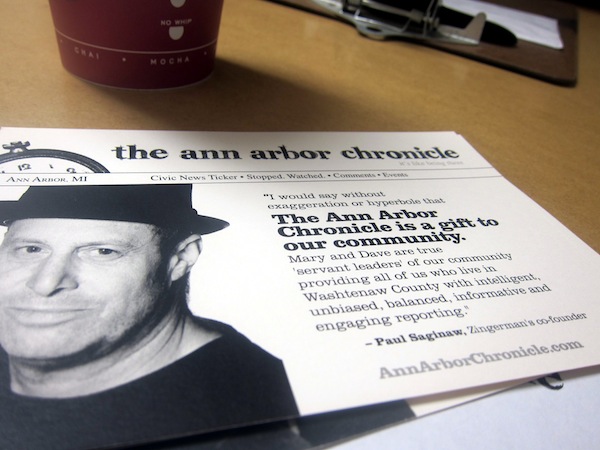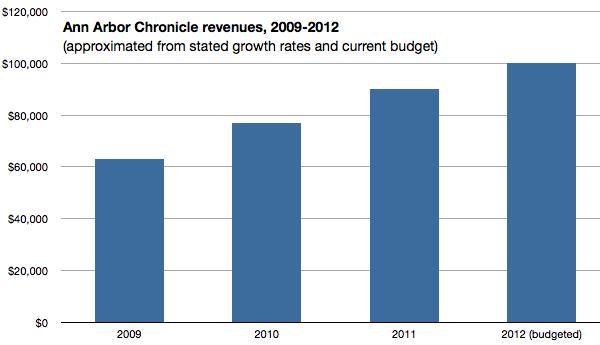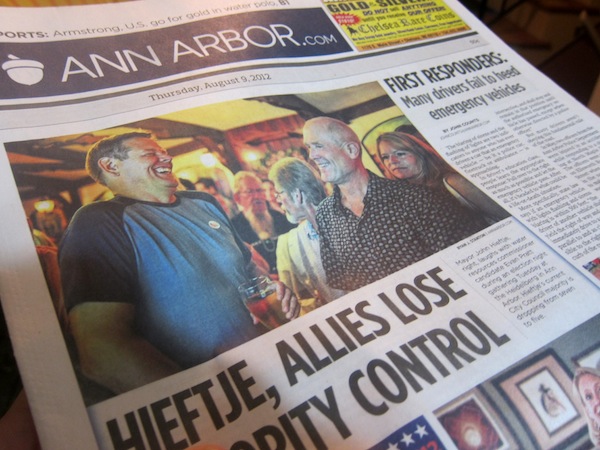

For four years, Mary Morgan and Dave Askins have been the change David Simon was waiting for.
The married couple’s website, the Ann Arbor Chronicle, doesn’t just cover the planning commission, as the Wire creator once suggested bloggers never would; it covers the taxicab board. It doesn’t just publish local election results; it publishes fact-checked 13,482-word summaries of the fifth-ward city council candidate forum, 10 days after the event took place. Morgan, Askins, and seven paid freelancers contribute. On a busy day, the Chronicle posts three stories; on a slow day, it posts nothing.

It’s one of the oddest local-news startups in the country, and one of the most idealistic. It’s also, Morgan and Askins say, bringing in $100,000 a year and growing by 16 percent annually.
When we last caught up with the Chronicle, in 2009, this Michigan college town of 114,000 had just lost its only daily newspaper. Advance Publications had folded its Ann Arbor News, dismissed 55 employees, and replaced the company with AnnArbor.com, a high-volume news website that publishes a print edition on Thursdays and Sundays.
This summer, Advance said the AnnArbor.com model is going national. In July and August, the company tapped six more papers, including New Orleans’ Times-Picayune, to end daily print publication. It seemed like a good occasion to revisit the Chronicle and get their advice on running a news startup in a post-daily town — as well as their take on AnnArbor.com, which Morgan (a former News staffer and, obviously, a competitor) describes as “a train wreck.”
For news entrepreneurs looking to follow in the Chronicle’s footsteps, here’s some wisdom from four years of shoe leather.
“When we launched, I was naively thinking that the small-pebbles-to-large-boulders approach would be better,” Morgan, who acts as publisher and handles all ad sales, told me. At launch, the Chronicle’s cheapest ad position sold for just $100 a month — and though Morgan managed to singlehandedly juggle 111 separate ad accounts in 2009, she soon realized she was wasting her time.
“It takes a lot of hand-holding to sell maybe a small ad once to a small business to whom that $100 is very important,” said Morgan. So in 2011, she doubled their ad rates and targeted “larger institutions [for whom] spending five, six thousand dollars with us is like a pittance in their overall plan”: Zingerman’s Deli, Ann Arbor State Bank, the University of Michigan.
The number of different Chronicle advertisers plummeted to 46 last year, according to the site. But the higher prices kept ad revenue steady — and Morgan saved a lot of sales calls.
Though the Chronicle is a for-profit LLC, 25 percent of revenue last year — $22,000, by their numbers — came from voluntary “subscriptions” and contributions from readers. Every one of the Chronicle’s vast, meticulous posts about local government deliberation now finishes with a solicitation to join, though Askins is careful never to call it a “donation.”
“To me, that has the stink of desperation about it,” said Askins, the Chronicle’s editor. “I don’t want it to be a charitable enterprise. I want it to simply be somewhat recognized: ‘That’s a thing of value. I need to support that.'”
To build awareness of their subscription program, the couple this summer invested $4,000 in a postcard mailing to the 8,500 locals who’d showed up to vote on a recent school bond issue — or, as Morgan calls them, “our base.”
It didn’t bring in $4,000 in new donations, they said. But Askins expects they’ll do another mailing someday, because he thinks it retains their existing donors and proves to their fans that they’re making efforts to grow.

Morgan and Askins haven’t considered offering premium content to subscribers; their pitch to donors, after all, is that support for the Chronicle is “a gift to the community.” Instead, the main benefit of Chronicle membership is an invitation to its annual Bezonki Awards — a civic-recognition affair that, this summer, featured free appetizers, a cash bar, a set of custom cocktails including the “ink-stained wretch,” and, for old time’s sake, a filing cabinet containing a bottle of scotch.
Morgan is also dreaming of inviting Chronicle groupies to join them at a local bar for a Mystery Science Theater-style viewing of a televised city council hearing. “There are people who would do that,” she said.
Morgan, a former business editor for the News whose fashion trademark is a pair of typewriter-key earrings, said her ad sales pitch never includes attacks on AnnArbor.com. But when the subject came up in our interview, Morgan didn’t mince words. “What’s happened here is clearly a train wreck in terms of journalistic integrity, ability to cover the community,” Morgan said.
The site’s new staff is dominated by non-locals who are “a couple years out of college, maybe,” Morgan said. In the time a single Chronicle freelancer was covering public schools, she said, AnnArbor.com cycled through three different beat reporters.

“In a university town, you’re going to have some young reporters,” Morgan acknowledged. “But for God sakes, you’re going to have some veterans who will be able to say, ‘Wait a minute, that’s not the name of the street, or you know, that person a year ago was embezzling.'” AnnArbor.com has lost its institutional knowledge, Morgan said, and the town is suffering.
In their characteristically massive columns dissecting AnnArbor.com, she and Askins risk coming off as cranks. But it’s obvious that they’re not the only Ann Arborites dismayed by the reduced quality of Advance’s operation, even as the company reports a high digital share of the local audience. And it’s just as obvious that public resentment of Advance’s cutbacks is important to the Chronicle’s business model.
(Paula Gardner, AnnArbor.com’s community news director, declined to comment for this piece. She referred questions to Advance’s regional headquarters in Grand Rapids, which didn’t return a request for comment. Advance’s Steve Newhouse defended the model to Poynter here.)
Morgan and Askins are eager to note that the Chronicle’s content model — governance without politics, simplicity without brevity — is unusual. The local news business needs more strange ideas, Morgan says.
“One thing that’s really striking to me is how uncreative and unimaginative most of the new media is,” she said. “There are, one would imagine, endless opportunities for niche publications or mainstream publications. But by and large, people are just doing the same thing…spot news…police blotter, council meeting.”
But what if that’s simply because spot news is what readers want?
In Ann Arbor, at least, readers seem to want deeply informed procedural reporting, too — Morgan and Askins have the modest lifestyle to prove it. And as they focus on drumming up enough subscriptions to hire more freelancers, they’re hoping for a breakthrough in voluntary support.
“When you’re trying to get the fog off the bathroom mirror with a hair dryer, you hold it there and nothing happens, nothing happens, nothing happens,” said Askins. “And somehow when you reach that point, suddenly it all goes away. I think it’s that idea. We just need to hold the hair dryer there a bit longer.”